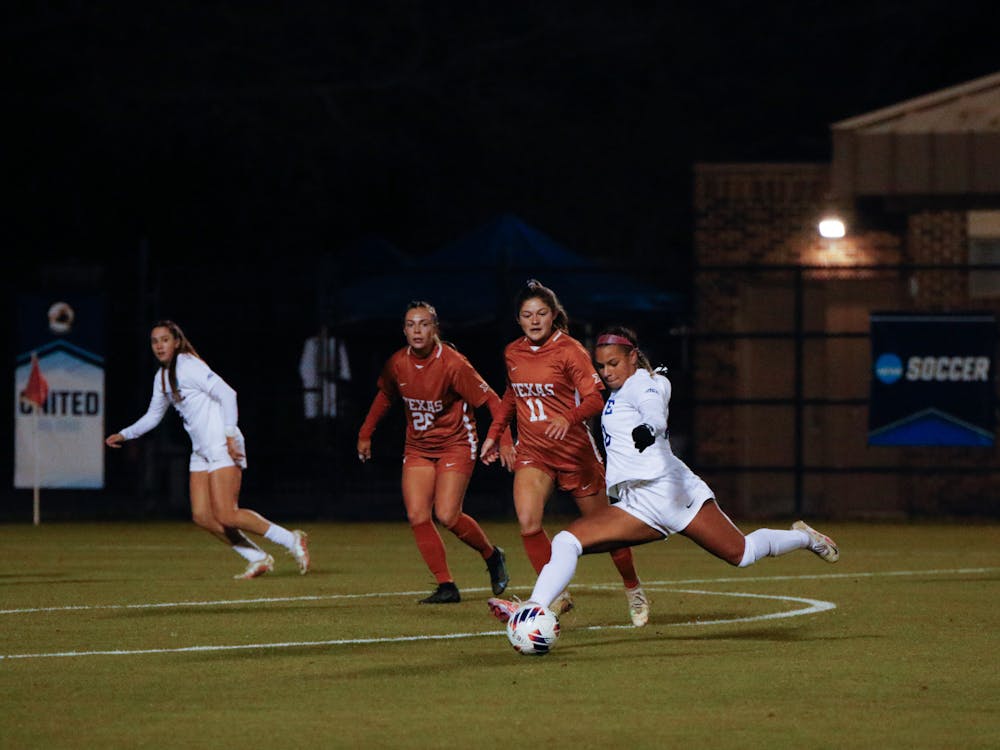Slow and steady wins the race, and that was certainly the case as Duke defeated Texas in the second round of the NCAA tournament with a late bang from junior Katie Groff, who found the back of the net with 2:18 remaining in regulation.
The goal came at the tail end of a game during which the Blue Devils had asserted their control and dominance. Yet, it marked the only score. The reason? Playing quick is not always the easiest approach, and when two teams are playing for the opportunity to win and advance to the College Cup, nothing is left unchallenged.
In Friday night's matchup against Texas at Koskinen Stadium, No. 2-seed Duke needed a powerful approach to come out as the victors. Arsenal head coach Arsene Wenger famously reclaimed his squad's 2016-17 season by restitching his 4-2-3-1 formation into a 3-4-2-1. Similarly, Duke needed to stay alive and also showed off a strong tactical look to do so.
After its loss in penalty kicks to North Carolina in the ACC tournament, head coach Robbie Church said that his team has been the most adaptable he's seen in his 24 years with the program. When it needed to adapt, Duke utilized a similar formation to the 3-4-2-1. The formation focuses on a transition-heavy outlook on the game, allowing several tactical facilitators to move the ball from the defensive side to the striker’s foot.
The arrangement allowed the Blue Devils to keep the majority of ball possession—60% throughout the game—while also trying many offensive approaches before finally getting their game-winning goal.
“As we all know, in soccer, sometimes controlling the game doesn’t mean that you’re going to score goals with it,” Church said after the win.
Duke began the night with a triangle configuration in the back from center back duo Jenna and Emily Royson and fellow defender Groff, allowing it to keep unobstructed possession from the first horn. The Blue Devils’ spread-out arrangement across the field allowed the defensive side to restrict the seventh-seeded Longhorns from settling into their offense, instead propelling the ball down the pitch to Duke's attacking side where it stayed for a good chunk of the night.
Ultimately, Duke kept its possessions away from senior keeper Ruthie Jones’ box and controlled possession near Longhorn goalkeeper Savannah Madden’s box for 27% of the Blue Devils' possession time.
Midfielders Sophie Jones and Delaney Graham took good care of the ball in transition through interceptions and playmaking to get it to the players up top. For the first half and the beginning of the second, that role was on the shoulders of forwards freshman Kat Rader and sophomore Michelle Cooper and graduate midfielder Mackenzie Pluck.
Combined, the three acting forwards took 14 of Duke’s 20 shots. While the Blue Devils took its fifth most shots in a game this season, the barrage marks the most significant offensive output the team has produced against a ranked team.
“Especially with our forwards, they love to take it—Michelle and Kat have been hitting bangers all season. So we like to get them the ball,” Groff said. “And when they have it, they like to shoot. So I wouldn’t say it’s a different strategy or anything that we did today. But we just happened to dominate the ball.”
Just five of the 20 shots were on goal because of adjustments Texas made to counter Duke’s attacking advantage. While the Longhorns did not struggle defensively, their errors allowed the Blue Devils to go for the goal each time the opportunity was there. Texas had to play a defensive game that required pulling back its forwards to the midfield while ending its night with six offside calls and four saves from the Longhorn goalkeeper.
A faked free kick taken by Lexi Missimo with 21 minutes remaining in regulation and a near shot toward goal by Trinity Byars with less than five minutes remaining—the visitors' best chances at scoring—were both stuffed by Duke’s speed on defense. The first shot was a far miss from the post while the latter got deflected, exemplary of the Blue Devils’ success in formation on both sides of the field.
In Wenger's case, the formation change resulted in a happy ending to Arsenal’s story that year; it went on to win its 13th FA Cup. While the Blue Devils did not completely change formations like the English squad, it just needed to adapt its approach to comfortably command the game before connecting with the game-winner.
Duke will continue its hunt for a championship of its own when it takes on South Carolina at home Sunday night.
Get The Chronicle straight to your inbox
Signup for our weekly newsletter. Cancel at any time.

